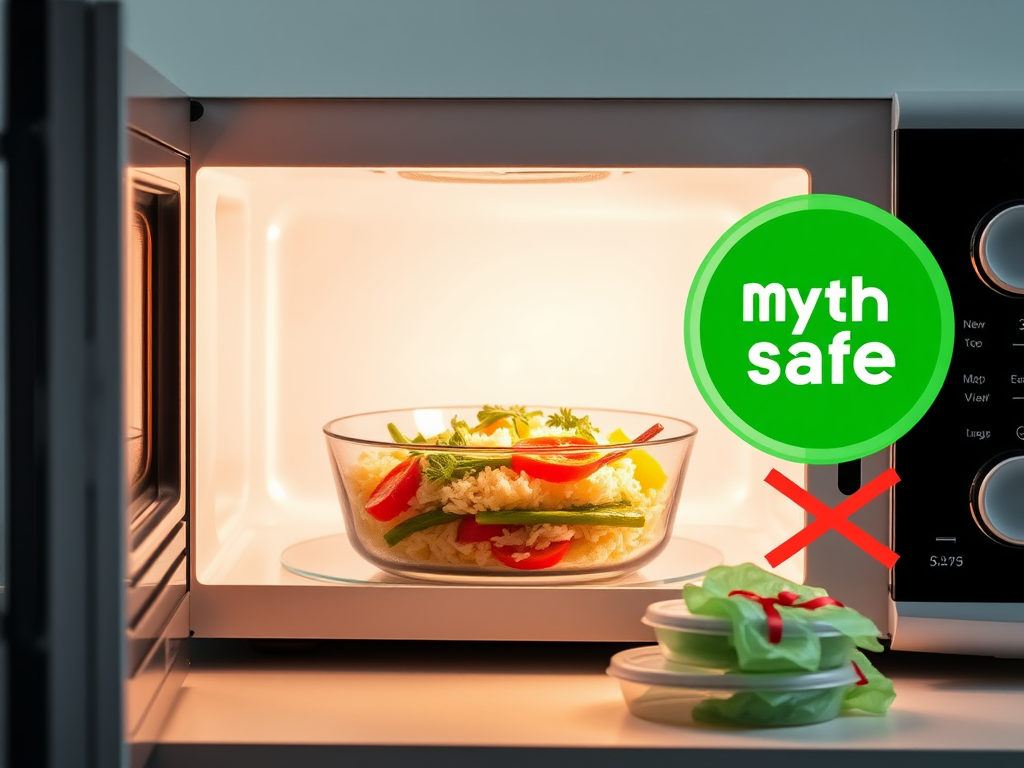Microwaves have long been a staple in kitchens worldwide, offering convenience and speed for reheating meals or cooking on the go. But a lingering concern persists: “You’re still using a microwave? Aren’t you afraid of cancer?” If you’ve ever heard this—or maybe even wondered about it yourself—this blog post is for you. Let’s dive into the science, separate fact from fiction, and uncover what’s risky when it comes to using a microwave. This discussion is inspired by a recent thread from DietBloom on X, posted on April 26, 2025.
Can Microwaves Cause Cancer? The Science Says No
The fear that microwaves cause cancer often stems from a misunderstanding of how they work. Microwaves use non-ionising radiation to heat food. Unlike ionising radiation (like X-rays), which can damage DNA and potentially lead to cancer, non-ionising radiation simply makes water molecules in your food vibrate, creating heat. It’s a straightforward scientific process that doesn’t make your food “radioactive” or “contaminated.”
Research supports the safety of microwaves. A 2024 article from WebMD confirms that microwave oven radiation doesn’t cause cancer, as it lacks the energy to alter the chemical makeup of your food or damage cells. The only non-ionising radiation linked to cancer is UV light, not the type emitted by microwaves. Additionally, microwaves can be a healthier cooking option because they cook food quickly, minimising nutrient loss. They often require little to no water, which is especially beneficial for preserving heat-sensitive vitamins in vegetables, compared to boiling or frying.
So, the idea that microwaves directly cause cancer? It’s a myth.
The Real Risk: It’s Not the Microwave, It’s the Container
While microwaves themselves are safe, the thread points out a critical oversight that many of us are guilty of: using the wrong containers. How often have you reheated food in a random plastic container—an ice cream tub, a takeaway pack, a yoghurt container, or a disposable food bowl? That’s where the real health risk lies.
Many plastics aren’t designed to withstand the heat of a microwave. When heated, they can leach harmful chemicals like BPA (bisphenol A) and phthalates into your food. According to the National Centre for Health Research, these chemicals are concerning because they can disrupt hormones and, with high, long-term exposure, have been linked to serious health issues, including an increased risk of cancer. BPA, for instance, is often found in hard plastics (marked with a #7 recycling code) and the lining of canned foods, while phthalates are used to soften plastics. Although the FDA banned BPA in baby bottles and sippy cups in 2012, it’s still present in many other products.
The danger isn’t the microwave itself—it’s how we use it. Heating food in non-microwave-safe plastics can turn a convenient appliance into a source of chemical exposure.
How to Use Your Microwave Safely
The good news? You can still enjoy the convenience of your microwave without worry if you follow a few simple guidelines. Here’s what the DietBloom thread recommends for safe microwave use:
- Use Microwave-Safe Containers: Opt for glass, ceramic, or BPA-free plastic containers. These materials are designed to handle heat without leaching harmful chemicals into your food.
- Avoid Thin Plastics: Skip reheating food in takeaway packs, disposable bowls, or other thin plastics that aren’t labeled as microwave-safe.
- Cover Food Lightly: Don’t seal your food tightly when microwaving. Use a loose cover to allow steam to escape safely.
- Reheat in Short Bursts: Avoid overheating your food. Reheat in short intervals to prevent excessive heat buildup that could damage containers or overcook your meal.
By making these small adjustments, you can minimise any potential risks and continue using your microwave with confidence.
What People Are Saying: Real Experiences and Lingering Doubts
The thread sparked some interesting responses from the X community, reflecting a mix of relief, scepticism, and curiosity. One user,
@GaGirl, shared a personal perspective: “I’ve had a microwave ever since they came in the market. I’m 74 and reasonably healthy, not taking any meds. For the last 9 years, I cook most of my meals in the microwave.” Her experience aligns with the scientific consensus that microwaves are safe when used properly.
However, not everyone is convinced.
@Pappi_xz raised a valid concern about trusting health claims, referencing past assurances about the safety of COVID vaccines that later faced scrutiny: “We were told sometime back COVID vaccines were harmless. Doctors backed that claim but today we see what it really is.” This scepticism highlights the importance of transparency and ongoing research in health-related topics. While the science on microwaves is well-established, it’s always wise to stay informed as new studies emerge.
Another user,
@BloodOfZee, brought up a related food myth, asking, “What’s the truth and myth regarding too much pepper in food causing ulcer?” DietBloom responded by linking to a previous thread they posted on April 2, 2025, which debunked that myth—spicy food doesn’t cause ulcers, though it may irritate existing ones in some people. This exchange shows how interconnected food myths can be and underscores the value of platforms like DietBloom in addressing these concerns with evidence-based insights.
Microwaves have been unfairly vilified in the realm of kitchen appliances, but the science is clear: they don’t cause cancer. As we’ve explored, their non-ionising radiation is safe, and they can even be a healthier cooking option by preserving nutrients in your food. The real concern lies not in the microwave itself, but in the containers we use—non-microwave-safe plastics can leach harmful chemicals like BPA and phthalates into our meals, posing potential health risks with long-term exposure. By making simple changes, like using glass or ceramic containers and following safe reheating practices, you can enjoy the convenience of your microwave without worry. Platforms like DietBloom are invaluable for cutting through the noise of food myths, offering science-backed insights to help us make informed choices. So, the next time someone questions your microwave use, you can confidently set the record straight—and maybe even share a tip or two about keeping it safe. What’s the next food myth you’d like to debunk? Let’s keep the conversation going!
Related Posts
- SHA: Your Benefits Breakdown – What Every Teacher Gets Based on Job Group
- TSC Unveils Comprehensive Medical Cover for All Teachers Starting December 2025
- Tragedy Strikes KJSEA Marking Exercise as Examiner Dies at Machakos Girls High School
- Shadows of Empire: How the West Maintains Control in Africa
- Why Senator Okiya Omtatah Wants to Abolish the Bomas National Tallying Centre (And Why It Matters for 2027)
- What to Study Now for a Successful Career in Kenya’s Future (2026-2050)
- AUDIT SHOCK: Only 3,000 Schools Get Capitation Funds as Govt Cracks Down on “Ghost Students”
- TSC’s Promotion Blueprint: How Teachers Earn Their Next Grade
- TSC CAREER OPPORTUNITIES: Deputy Director & Assistant Director Positions
- TSC 24,000 TEACHER INTERN VACANCIES
- EGYAID Scholarship Program 2025-2026
- Oman Scholarship Program 2025-2026
- 2026 COMMONWEALTH PhD & MASTERS SCHOLARSHIPS
- Papaya Seeds: Nature’s Hidden Powerhouse
- Guide to Teacher Promotion with TSC
- Teacher Transfer Process Tutorial
- History of Teachers Service Commission (TSC)
- TSC Launches Digital Teacher Transfer System: Here’s How It Works
- TSC TEACHER PROMOTIONS 2025-2026 GUIDELINES
- TSC TEACHER PROMOTIONS 2025-2026
- TEACHER TRAINER VACANCIES (JUNIOR SCHOOL LEVEL)
















